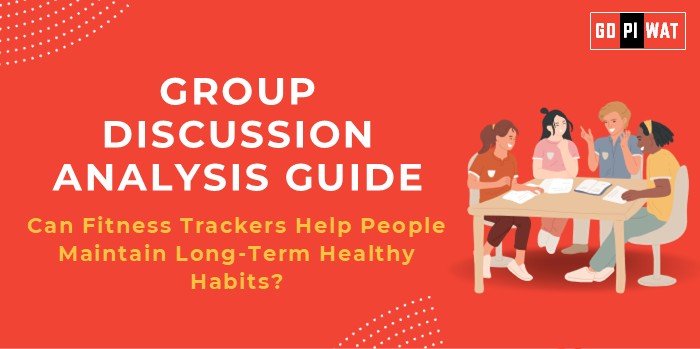📋 Group Discussion (GD) Analysis Guide: Can Fitness Trackers Help People Maintain Long-Term Healthy Habits?
🌐 Introduction to the Topic
Opening Context: The rise of wearable technology, such as fitness trackers, marks a significant shift in how individuals monitor and manage their health. This trend aligns with a global focus on preventive healthcare.
Topic Background: Fitness trackers like Fitbit, Garmin, and smartwatches aim to promote physical activity, healthy diets, and better sleep habits. Their effectiveness in sustaining long-term behavioral change remains a critical discussion point for health professionals and technology developers.
📊 Quick Facts and Key Statistics
- Market Size: $68 billion globally (2023) – Illustrates the growing adoption of fitness trackers.
- Adherence Boost: 57% of users maintain physical activity goals after six months (Journal of Behavioral Medicine).
- Obesity Rates: 39% of adults globally are overweight (WHO 2023) – Highlights the urgent need for tools promoting healthy habits.
- Smartphone Integration: Over 75% of trackers sync with health apps – Facilitates comprehensive health data analysis.
👥 Stakeholders and Their Roles
- Consumers: Seek personalized health insights and motivation for long-term wellness.
- Healthcare Providers: Use data for patient monitoring and preventive care.
- Tech Companies: Innovate wearable technologies and health apps.
- Government Bodies: Regulate privacy and promote population-wide health strategies.
📈 Achievements and Challenges
✅ Achievements:
- Increased Activity Levels: Wearable users take 1,000+ more steps daily on average.
- Chronic Disease Management: Trackers aid in monitoring conditions like diabetes.
- Community Impact: Challenges and gamification foster peer motivation.
⚠️ Challenges:
- Drop-Off Rates: Up to 30% of users stop using trackers after a year.
- Data Privacy: Breaches risk exposing sensitive health data.
- Accuracy Issues: Variations in step counts or calorie tracking can reduce trust.
🌍 Global Comparisons:
- USA: Widespread adoption, particularly for corporate wellness programs.
- Japan: High reliance on wearables integrated with healthcare systems.
📝 Structured Arguments for Discussion
- Supporting Stance: “Fitness trackers have transformed personal healthcare by promoting self-awareness and consistent behavior change.”
- Opposing Stance: “Long-term reliance on fitness trackers is unsustainable due to declining engagement and potential data inaccuracies.”
- Balanced Perspective: “While fitness trackers offer valuable initial motivation, their effectiveness depends on user engagement and data accuracy.”
💡 Effective Discussion Approaches
- Opening Approaches:
- “57% of users meet their fitness goals within six months.”
- “Yet, nearly one-third abandon trackers within a year.”
- Counter-Argument Handling: Address privacy concerns by highlighting advancements in encryption technologies.
🔍 Strategic Analysis of Strengths and Weaknesses
Strengths:
- Gamification for motivation.
- Broad accessibility via smartphones.
Weaknesses:
- User retention challenges.
- Cost barriers for low-income populations.
Opportunities:
- Integration with AI for personalized insights.
- Expansion in underserved regions.
Threats:
- Rising competition and cybersecurity risks.
📚 Connecting with B-School Applications
- Real-World Applications: Links to healthcare management, technology strategy, and data analytics projects.
- Sample Interview Questions:
- “How can fitness trackers drive innovation in preventive healthcare?”
- “Evaluate the role of gamification in sustaining health habits.”
- Insights for Students: Focus on tech-driven health solutions and explore privacy versus utility debates.


